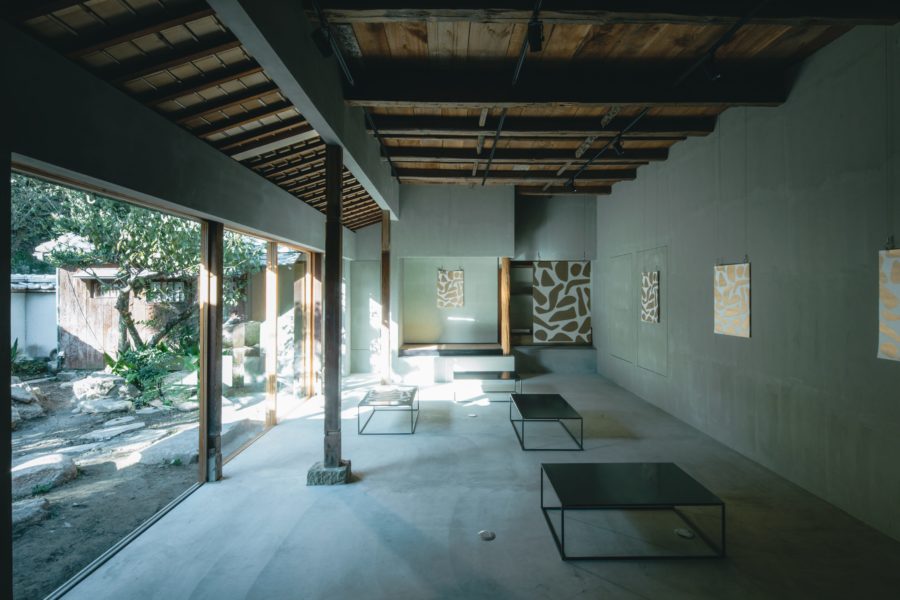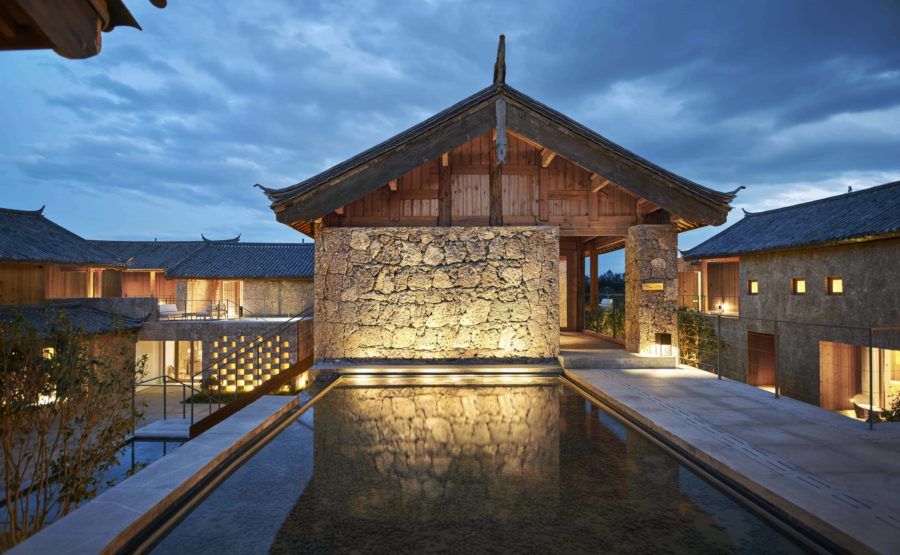大阪に次ぐ工業都市といわれる倉敷に、創業90年を迎える粘着テープ工場がある。粘着技術を駆使した製品を生産し続けてきた歴史ある工場だ。原料や製造した製品の搬出入の便を図るために選ばれた広大で平坦な敷地のすぐ隣には住宅地が広がり、工場の切妻屋根がいくつも連なり、この場所の独特の日常の風景になっている。その中に、第三撹拌工場という唯一の2階建て鉄筋コンクート造の建物がある。2階の床には8つの穴があいていて、階段と荷物用エレベータ用のほかに、整然と並ぶ6つの穴がある。その規則正しさから、粘着剤の製造に使われた機械がその穴から頭を覗かせていたことを想像するのは容易であった。
広大な敷地をもつ工場にとって、2階建ての建物は必要ないだろう。製造ラインや保管・搬出入を考えれば機能的でないのは明らかだ。体育館のようながらんどうの平屋空間に対して、この第三攪拌工場だけは材料を投入するためだけの機能的な吹き抜けをつくるために、2階の床が必要だったのである。工場の辺り一帯の地面をそのまま建物に引き込み、吹き抜けを挟んだ上階を大きな明るい屋根裏にすることで、工場の中で新たな場所性を獲得できないかと考えた。
爆発を考慮された工場特有のスレート屋根とブロック積みの壁を取り払い、建築の骨格と縁を切るように吹き抜けに柱を建て、真っ白な大きな屋根を架けた。この建ち方は減築でも増築でも改築でもない。古い建物を単に保存する計画でも再生する計画でもない。この場所に、工場のこれまでの歴史とともに倉庫、史料室、食堂、休憩室、会議室、駐車場といった今まで工場に点在していた場所を凝縮させることで、新しい工場を「凝築」した。ここが新しい接着材を生産する工場になればと思っている。(武井 誠+鍋島千恵)
A historical museum that has been renovated by condensing the characteristics of the factory
In Kurashiki, the second largest industrial city after Osaka, there is an adhesive tape factory that has been in business for 90 years. It is a factory with a long history of producing products that make full use of adhesive technology. The vast, flat site was chosen to facilitate the loading and unloading of raw materials and manufactured products and is immediately adjacent to a residential area where the gabled roofs of the factory are lined up in a row, creating a unique everyday landscape of this place. In the midst of all this is the only two-story reinforced concrete building called Agitation Plant No. 3, with eight holes in the second floor, six of which are neatly lined up, in addition to those for the stairs and the baggage elevator. From the regularity of the holes, it was easy to imagine that the machines used to make the adhesives were peeking out of them.
For a factory with a vast site, a two-story building would not be necessary. It is not functional considering the production lines, storage, loading, and unloading. The third agitator factory was the only one that needed a second floor to create a functional atrium just for loading materials instead of a flat, one-story space like a gymnasium. The ground around the factory was pulled directly into the building, and the upper floor across the atrium was made into a large bright attic, which I thought would give the factory a new sense of place.
The factory’s slate roof and block walls, which were designed to prevent explosions, were removed, and pillars were erected in the atrium to separate them from the architectural framework, creating a large, pure white roof. This method of construction is neither a reduction, an extension, nor a renovation. It is not a plan to simply preserve or revitalize an old building. Instead, the new factory was “condensed and built” by condensing the factory’s history into this location, as well as the warehouses, archives, cafeteria, break room, conference room, and parking lot that had been scattered throughout the factory. We hope that this will become a factory that produces new adhesive materials. (Makoto Takei + Chie Nabeshima)
【カモ井加工紙第三撹拌工場史料館】
所在地:岡山県倉敷市
用途:倉庫、その他文化施設
クライアント:カモ井加工紙
竣工:2012年
設計:TNA
担当:武井 誠、鍋島千恵、綾城 圭
構造設計:満田衛資構造計画研究所
施工:藤木工務店
撮影:阿野太一
工事種別:リノベーション
構造:混構造
規模:地上2階
敷地面積:23998.45m²
建築面積:206.60m²
延床面積:369.07m²
設計期間:2010.12-2011.08
施工期間:2011.09-2012.01
【The Third Stir Factory of Kamoi Kakoshi】
Location: Kurashiki-shi, Okayama, Japan
Principal use: Warehouse
Client: KAMOI KAKOSHI
Completion: 2012
Architects: TNA
Design team: Makoto Takei, Chie Nabeshima, Kei Ayashiro
Structure engineer: Mitsuda Structural Consultants
Contractor: Fujiki Komuten
Photographs: Daici Ano
Construction type: Renovation
Main structure: Mixed structure
Building scale: 2 stories
Site area: 23998.45m²
Building area: 206.60m²
Total floor area: 369.07m²
Design term: 2010.12-2011.08
Construction term: 2011.09-2012.01








